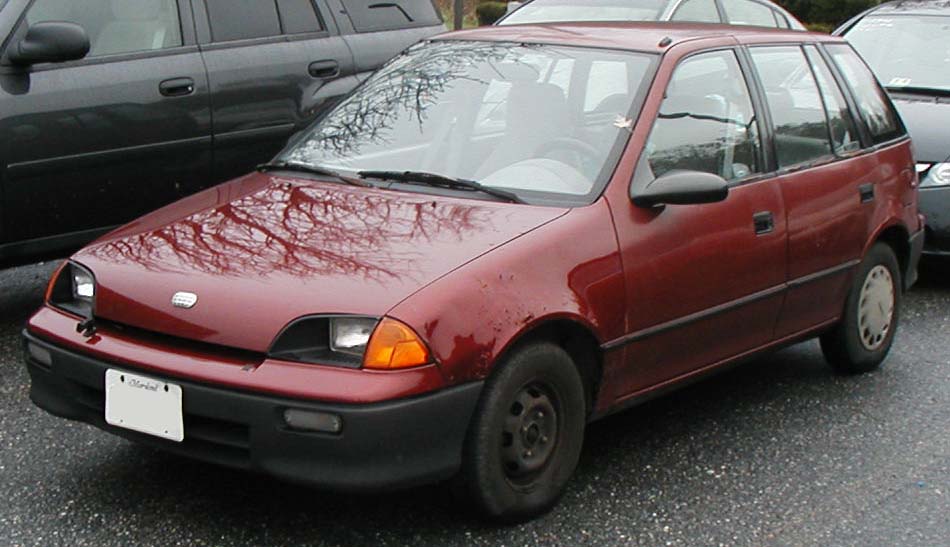
What's more, the Insurance Institute for Highway Safety (IIHS) gave the Prizm a five in its overall reliability rating unlike its competition, 1997 Pontiac Sunfire, which only received a four.
#1990 geo 5 door hatchback driver#
In fact, the 1993-1997 model of Geo Prizm had 4-wheel anti-lock brakes (ABS), driver and passenger front impact airbags, daytime running lights, and center mounted stop light. Though the cars manufactured by Geo were based on Japanese cars, it did not disappoint those who bought it when it comes to reliability and safeness. Compared to a 1990 Ford Festiva which had a combined MPG of 28 or 3.35 USD per 25 miles, the Metro is way more fuel efficient-just what we need to counter increasing gas prices. This means that it would only cost 2.29 USD to drive 25 miles or 1350 USD annually. Based on the US Department of Energy, the 1990 Geo Metro had a combined MPG of 41. If Geo was still in the market, people would be able to buy their fuel-saving cars and save hundreds of dollars. We're living in a time when gas and diesel cost about 3.74 USD per gallon. Let's take a drive down memory lane and list the top reasons why we miss Geo. If you're one of those lucky people who experienced driving a Geo, then you probably miss the brand, too. However, in 1997, GM decided to pull the plug on Geo because of its declining sales over the years. Through GM's joint ventures with Japanese automakers, Geo became very successful during its prime. General Motors (GM), one of the biggest automakers in Canada and the US, introduced in 1989 their small car brand to face this growing demand-Geo. In the late 1980s, the demand for imported automobiles grew, so car manufacturers in the United States decided to establish divisions focused on import-style sales. However, when Geo was dissolved, Chevrolet badged the Tracker until it was officially discontinued in 2004. The Tracker was favored by car owners who liked going off-road because it was designed to withstand harsh driving and environmental conditions.

It also had a 4-cylinder engine that delivered 94 pound-feet torque and 80 horsepower. Though it looked like a small SUV, the Tracker was actually certified as a light truck because of its light-truck chassis. Manufactured by GM and Suzuki, the Tracker was a mini SUV under the Geo brand from 1989 to 1997. Compared to other car models produced in the same year that only made 108 HP for every 2,291 pounds, the Storm was cheaper and worth every penny. Aside from its appearance, this Geo model weighs 2,392 pounds and has a 4-cylinder engine that can produce 130 HP.

With an MSRP of 11,650 USD, the Storm was a hit with teenagers even though its "modern" design did not impress older car owners. engine as a solution to the oil price hike in the US.įrom 1990 to 1993 Geo, together with Isuzu, manufactured the sport compact car Geo Storm. In fact, because of the Metro's impressive MPG, other car manufacturers, such as Ford, are re-introducing the 3-cyl. With a combined MPG of 41, the Geo Metro is recognized as the fourth most fuel efficient vehicle from 1984 to present by the US Department of Energy. The engine also made this model very fuel efficient. The 1990 base model, for instance, was equipped with a 1-liter 3-cylinder engine that made Metros more compact and cheaper than other cars made in the same year. Sold as sedans, convertibles, and hatchbacks, the Metro was known for its impressive fuel economy. Listed below are some of Geo's notable car models and their contributions to the automobile industry. Nonetheless, for eight years, Geo manufactured different car models still recognized today. However, GM eventually decided to close Geo in 1997 because it failed to establish a solid market share. As one of the three biggest manufacturers during that time, General Motors (GM) established its own division in 1989-Geo.
_(front)%2C_Kuala_Lumpur.jpg)
Geo: How It Changed the Industry for Eight Yearsĭue to the increasing sales of the import market in the mid 1980s, many car manufacturers in the US and Canada launched import-focused divisions.


 0 kommentar(er)
0 kommentar(er)
